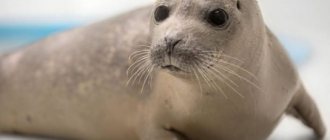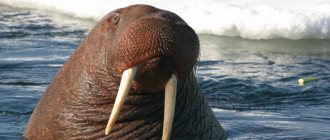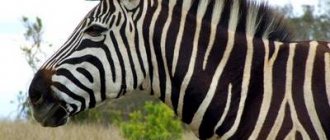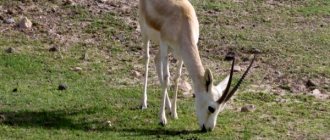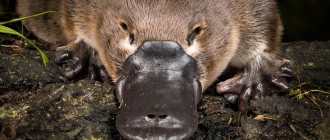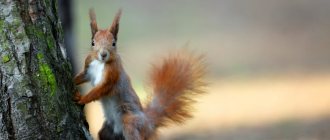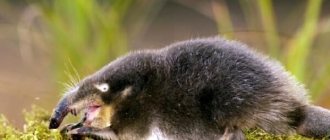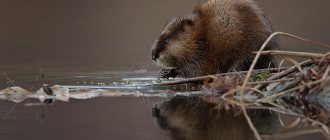- Where does the seal live?
A true sea bumpkin, the seal is one of the amazing representatives of the animal world of our planet, combining both marine and terrestrial lifestyles. In a broad sense, seals mean all representatives of the order Pinnipeds, mammals that, during evolutionary transformations, have developed real flippers instead of traditional paws. But usually by seals we mean animals from the family of true seals and our article is about them.
Description, structure, characteristics
The appearance of the seal is due to their aquatic lifestyle. On the one hand, flippers, which give the name to the whole species - “pinnipeds”, turn these clumsy land-based hulks into excellent swimmers. On the other hand, seals, unlike whales and dolphins, have not lost their connection with land, where they also spend a lot of time.
All seals are quite large animals. Thus, the mass of a seal, depending on the species, ranges from 40 kg (for the seal) to 2.5 tons (for the sea
elephant). Also, the body length of a seal varies from 1.25 meters for the seal, the smallest among the family of true seals, to 6.5 meters for the elephant seal, whose name speaks volumes about the largest size of this type of seal. And what’s interesting is that many seals of the same species can change their size depending on the season, since they tend to accumulate seasonal reserves of fat, which then disappear.
The shape of the seal's body is elongated and streamlined, the neck is short and thick, it is crowned by the seal's head, which is relatively small in size, but has a flattened cranium. Seal flippers have very developed hands and feet.
The seal's body is covered with short and stiff hair, which, on the one hand, does not impede their movement under water, and on the other, protects its owner from the cold. Also, seals are protected from the cold by the reserves of subcutaneous fat accumulated by seals for the winter. In fact, this subcutaneous fat of seals performs a thermoregulatory function, allowing animals to easily endure the harsh Arctic and
Antarctic cold. Most seal species are gray or brown in color; some species have a mottled pattern.
When you look at a photo of a seal, it seems that this creature is very clumsy and slow on land, and this is true, since when moving, seals rely on their forelimbs and stomach, while their hind limbs simply drag along the ground. Moreover, considering the rather large mass of seals, it is really difficult for them to move on the ground. But once in the water, the seals are completely transformed; the slowness and clumsiness that is characteristic of them on land leaves no trace - in the water they are capable of reaching speeds of up to 25 km per hour. In addition, seals are excellent divers, capable of diving up to 600 m in depth.
True, seals can spend no more than 10 minutes under water, during which time the supply runs out
oxygen, which is in a special air sac (under the skin of the seal) and you have to return to land again.
The eyes of seals, although larger in size, nevertheless, their vision is not very well developed (as indeed, in all aquatic mammals), all seals are myopic. But poor eyesight is perfectly compensated by good hearing and especially sense of smell, so seals are able to detect odors at a distance of 300-500 meters. Seals also have so-called tactile whiskers (also called “whiskers”), with the help of which they navigate among underwater obstacles. It is also worth noting that some types of seals have the ability to echolocation, although it is much less developed in them than in whales and dolphins.
With the exception of a few species, seals do not have sexual dimorphism, that is, males and females look the same (only the hooded seal and elephant seal have males with a special “decoration” on their faces). As for the genital organs, in seals, like many other aquatic mammals, they are hidden in the folds of the skin and are not visible.
How are seals different from fur seals?
Fur seals have front flippers that help them move on land. Moreover, the rear flippers can bend. When moving, animals make short jumps. In turn, real seals cannot tuck their back flippers. They crawl on land like caterpillars and are very clumsy. Their fur is shorter or absent, but seals always have a thick coat.
Habitats
The habitat of seals is very wide, one might say that it is the entire globe. True, given the marine lifestyle of seals, they all live on the coasts of seas and oceans. Most of the species of these animals live in the cold latitudes of the Arctic and Antarctic, where, thanks to their subcutaneous fat, they can easily withstand the cold there, but there are also seals, such as the monk seal, that live in the warm Mediterranean.
Also, several species of seals, such as the Baikal seal, live in the inland lakes of the continents.
What do seals eat?
Seals are carnivorous animals that prefer to eat marine life such as shellfish, crabs and various types of fish. Cannibalism sometimes occurs, and some species may feed on penguins. Representatives of the walrus family can eat sea cucumbers and worms, but more often feed on cephalopods and crustaceans. Individuals from the family of eared seals eat flounder and sea bass. Those living in Asian waters prefer pollock and anchovy. There are also those who prefer such relatives as seals and seals.
Lifestyle
Although seals form group aggregations - so-called rookeries on the shores of seas and oceans, unlike other pinnipeds, they are much less characterized by a herd instinct. For example, they feed and rest separately, and only in case of danger they monitor the behavior of their brothers.
Seals are also very peace-loving creatures; they practically do not quarrel with each other, with the exception, of course, of the mating season, when several males seek one female, in such a situation even peace-loving seals can be furious.
As we wrote above, on the shore, seals are clumsy and slow, so in rookeries they deliberately position themselves closer to the water so that in case of danger they can dive into the water surface. Also, from time to time they simply dive into the water for prey and then we move on to the next point.
Types, photos and names
According to the zoological classification, there are 24 species of real seals; we will describe the most interesting of them.
Monk Seal
This type of seal is perhaps the most heat-loving among seals, since it prefers the warm waters of the Mediterranean, Hawaiian and Caribbean islands, where it actually lives, to the cold Arctic and Antarctic colds. Also, unlike other seals, it has a well-developed posterior part of the lower jaw. The body length of the monk seal is 2-3 meters and weighs 250 kg. It has a gray-brown color and a light belly, which is why it received its second name – the white-bellied seal. Interestingly, in the past, monk seals also lived in the Black Sea, and they could be found on the Black Sea coast of our country, but recently the population of these seals has decreased significantly; at the moment, all subspecies of the monk seal are listed in
Red Book.
Sea Elephant
As you might guess from the name, the elephant seal is the largest species of seal, its length can reach up to 6.5 meters and weighs 2.5 tons. Also, some properties with elephants are given not only by their large size, but also by the presence of a hot-shaped nose in male elephant seals. Depending on their habitat, elephant seals are divided into two subspecies: the northern elephant seal lives on the coast of North America, and the southern elephant seal lives in Antarctica.
Ross seal
Named after English explorer James Ross. This is a relatively small Antarctic seal, well, how small, its body length is about 2 meters and weighs 200 kg. It has a very thick folded neck, in which it can easily hide its head. Little studied because it lives in remote areas of Antarctica.
Crabeater seal
The crabeater seal, named for its gastronomic predilection for crabs, is also the most numerous seal in the world - according to various estimates, its number ranges from 7 to 40 million individuals. It has average dimensions for seals - body length - 2.2-2.6 meters, weight - 200-300 kg, long narrow muzzle. These seals live in Antarctica and the southern seas surrounding it; they often like to set up their rookeries on ice floes, swimming with them.
Leopard seal
Named for its spotted skin and predatory behavior, this species is considered the most dangerous and aggressive among seals. In particular, leopard seals do not hesitate to attack smaller seals of other species, but their favorite delicacy is penguins. The size of the leopard seal is larger than that of many other species of seals, second only to the elephant seal; its body length can reach up to 4 meters and weighs 600 kg. It lives along the entire coast of Antarctica.
Weddell seal
It was named after another Englishman - the British navigator Sir James Weddell, who was the commander of a research expedition to the Weddell Sea, during which this type of seal was first discovered by Europeans. Among other seals, the Weddell seal stands out for its remarkable ability to dive and stay under water - while many other seals can stay in the depths of the sea for no more than 10 minutes, this seal can swim for an hour. Also lives in Antarctica.
hooded seal
Unlike its counterparts described above, this seal lives in the Arctic, mainly on the coast of North America and Greenland. It differs from other seals in its spotted coloring.
harbor seal
This type of seal, represented by four subspecies (depending on their habitats), lives throughout the northern Arctic hemisphere: on the shores of North America, Scandinavia, and in the northern part of Russia. Some subspecies of the common seal are endangered due to poaching.
Long-faced seal
The long-snouted seal is so named because of its snout, which is long, even for seals. The body length of the long-faced seal is 2.5 meters and weighs up to 300 kg. It lives in the North Atlantic: on the coasts of Greenland, Scandinavia and Iceland.
harp seal
Another of the northern seals, living on the coast of Greenland itself. They differ from other species of seals in their characteristic coloring: only they have silver-gray fur, a black head, and a black horseshoe-shaped line that stretches from the shoulders on both sides. The harp seal is relatively small - its body length is 170-180 cm, weight - 120-140 kg.
Striped seal
It differs from other seals in its unusual striped coloration of white and black colors. Lives in the Berengov, Okhotsk and Chukchi Seas. The body length of the striped seal is 150-190 cm, weight – 70-90 kg.
Seal
The seal is the smallest species of seal, with an average body length of 1.5 meters and a weight of up to 100 kg. But this is on average, the smallest among the subspecies of seals is the Ladoga seal, which lives in Lake Ladoga itself and has a body length of no more than 135 cm and a weight of 40 kg. In general, seals live in the cold and temperate waters of the Pacific, Atlantic and Arctic oceans, as well as in large lakes and inland seas. Depending on their habitat, subspecies are distinguished such as the Caspian seal, the Baikal seal, and the Ladoga seal.
Nutrition
The diet of seals is based on marine inhabitants: mollusks, crabs, octopuses, squids, and large crustaceans. Most of the food is fish: smelt, cod, capelin, navaga, herring. Some mammal species have certain preferences.
Fish is the main food for seals
For example, the crabeater seal received its name for its preference for crabs to other aquatic inhabitants; for the leopard seal, the penguin will be a delicacy. Seals swallow small prey whole without chewing. The seal is a sea glutton and is not very picky about food, so swallowed stones weighing up to 10 kg accumulate in the stomachs of predators.
Reproduction
Seals, all species, breed only once a year. Their mating season usually begins at the end of summer. During this period, clashes are possible between competing males seeking the attention of one female. She, as expected, will eventually choose the strongest male for mating.
The pregnancy of a female seal lasts a year, after which only one baby is born. True, he is born as a fully developed and adapted seal. Small seal pups have white skin, which is why they are also called pups. They cannot accompany their mother in the water, so they spend most of their time on the shore or on a drifting ice floe. Very quickly feeding on fatty mother's milk, rich in proteins, they begin to mature and increase in size until they become adult, self-sufficient seals.
Ringed seal, or Akiba
(Pusa [Phoca] hispida), covered with coarse blackish-brown fur with numerous irregular white rings. The body length of an adult male is up to 1.8 m.
This is the only seal of all that builds a nest for its young. In March or April, when the ice begins to break, the female makes a burrow in a snowdrift with a tunnel leading to a vent and water. Newborns (sometimes twins) are covered with snow-white soft fur (the pup stage), which after a month gives way to darker fur.
The ringed seal appears to travel the furthest north of any mammal; She spends most of the year in ice-covered bays and fiords. In autumn, as the water freezes, the animal does not migrate south, but makes holes in the ice, to which it regularly swims up to breathe and rest. Sometimes this leads to a sad result, since a hunter with a harpoon or a polar bear may be waiting for him near such an opening. Usually the seal spends 8–9 minutes under water, but if necessary, it can remain there for up to 20 minutes. When she surfaces, she manages to stock up on air for the next dive in 45 seconds.
The ringed seal is distributed circumpolarly in the Arctic Ocean, reaching as far south as Labrador and the Bering Sea.
Video
And in conclusion, an educational documentary about our today's heroes - “The Mystery of the Caspian Seal Rookeries.”
Author: Pavel Chaika, editor-in-chief of Poznavaika magazine
When writing the article, I tried to make it as interesting, useful and high-quality as possible. I would be grateful for any feedback and constructive criticism in the form of comments on the article. You can also write your wish/question/suggestion to my email [email protected] or Facebook, with respect, the author.
Author page
This article is available in English -
Seals.
Meaning in nature
Every animal in the world around us plays its role. Seals are also important for ecology and humans. Mammals are a link in the food chain; they eat large quantities of fish, crustaceans and other inhabitants of water bodies. Thanks to this, the number of certain species is regulated, and enough plant food is preserved for those who do not consume animals.
Man has long hunted seals for their fur, skin and fat. The fur of young animals is especially valued, since it is very soft, and expensive, high-quality clothing is made from it. The skin of fur seals is considered the most valuable, so in many places the animals have almost disappeared.
Several species are already extinct, others are on the verge of extinction.
To control the number of endangered seals, many of them are listed in the Red Book.
